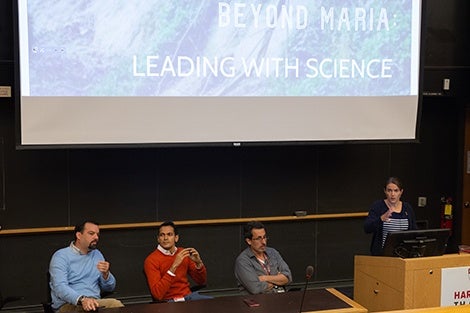September 28, 2018 – After Hurricane Maria slammed into Puerto Rico on September 20, 2017, statistician and genomics expert Rafael Irizarry of Harvard T.H. Chan School of Public Health, a native of Puerto Rico, was hearing dire reports of death and destruction from friends and family on the island. So when the governor of Puerto Rico announced in early December 2017 that there had been only 16 storm-related deaths, Irizarry thought the number sounded “impossible.”
Concerned that the Puerto Rican government was unaware of the storm’s true death toll, Harvard Chan School’s Caroline Buckee and Satchit Balsari initiated a study of storm-related mortality, working with co-authors including Irizarry and other experts from Harvard Chan School and Puerto Rico. Published last May, the study estimated that there had been somewhere between 800 and 8,500 excess deaths in Puerto Rico related to the hurricane through the end of December 2017.
A year after the storm, on September 21, 2018, Buckee, Balsari, Irizarry, and Domingo Marqués-Reyes, associate professor at Albizu University in Puerto Rico, discussed their study, other estimates of hurricane-related deaths, the difficulty of obtaining official mortality data, and the hardships Puerto Ricans faced in the weeks and months after Maria. Buckee moderated the panel.
Watch a webcast of the panel discussion
Estimating mortality
Buckee, associate professor of epidemiology, presented a timeline that showed the various points when hurricane-related death estimates were made over the past year. Penn State researchers, using partially released registry data from the Puerto Rican government, estimated that the storm had led to 1,064 excess deaths through November 21. On December 9, the Puerto Rican government placed the death toll at 64. That same day, the New York Times estimated a toll of 1,052. On December 18, the Puerto Rican government ordered a recount, and on February 22, 2018 it announced that George Washington University would conduct it. On May 29, Harvard Chan School released its study, drawing considerable media attention. Five days later, under intense scrutiny from the media and others, the government of Puerto Rico finally released all of its registry data, which showed that there had been nearly 1,400 excess deaths between September and December 2017. George Washington University’s study came out on August 27. It estimated that, through February 2018, there had been 2,975 excess deaths due to the hurricane—a number that was accepted by Puerto Rican authorities.
Irizarry, professor of biostatistics, spoke about the difficulty of trying to obtain official Puerto Rican death data, both from government officials and from other researchers working on their own estimates. When the Harvard Chan study came out, the researchers made all their data and code public so that others could reanalyze it. Their goal was to ensure the availability of as much hurricane-related death information as possible prior to the next hurricane season.
Balsari, research fellow at the FXB Center for Health and Human Rights, discussed the analytic method, known as cluster sampling, used in the Harvard Chan study. The researchers picked randomly chosen households in different parts of Puerto Rico and knocked on doors to ask if anyone in the house had died after the storm and how they had died. The researchers sought information not only on “direct” deaths—those that occurred during the storm, from either drowning or other weather-related accidents—but also “indirect deaths” that occurred in the storm’s aftermath, including those of people unable to receive needed medical treatment.
The Harvard Chan study revealed that illness and death continued for months after Hurricane Maria, driven by a loss of infrastructure—lack of electricity, lack of clean water, and lack of cell phone service, Balsari said. “This is something that we as public health practitioners have to be extremely attuned to, because we’re going to see this over and over and over again as our populations age and become more dependent on infrastructure for their medical care,” he said. “You need a refrigerator to refrigerate your insulin. You’re a dialysis patient, you need to be able to go to the dialysis center. If you have a nebulizer at home, you need to be able to plug the nebulizer into your power port.”
Emotional effects
Marqués-Reyes—who himself went about 90 days without power, 50 without running water, and 20 without cell service after the storm—discussed the hurricane’s emotional toll. He said many Puerto Ricans experienced survivors’ guilt and post-traumatic stress disorder. There were increases in domestic violence and alcohol use. Suicides and suicide-related hotline calls spiked.
Even months after the storm, there hadn’t been official acknowledgement of the magnitude of Puerto Rico’s losses, Marqués-Reyes said—“not even a minute of silence for the people that died.” But after the Harvard Chan study came out, people began a mourning process that was long overdue, including a “shoe memorial” in front of the capitol building in San Juan, in which each pair of shoes represented a life lost.
Marqués-Reyes said that people, organizations, and private companies in Puerto Rico are working hard to be prepared for the next big storm. People are now aware of the vulnerabilities of those who need dialysis and those who have respiratory or heart problems. “Now everyone knows that something as simple as high blood pressure can become deadly when you have no running water, nothing to drink and you’re eating Spam from a can,” he said.
photo: Nilagia McCoy
